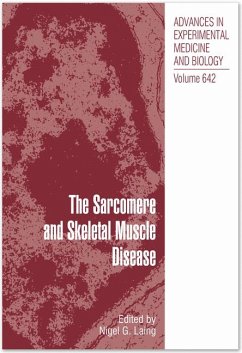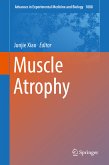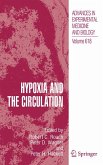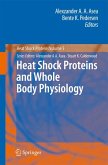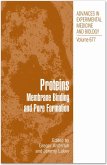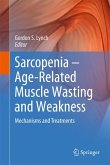The Sarcomere and Skeletal Muscle Disease (eBook, PDF)
149,79 €
inkl. MwSt.
Sofort per Download lieferbar

0 °P sammeln
The Sarcomere and Skeletal Muscle Disease (eBook, PDF)
- Format: PDF
- Merkliste
- Auf die Merkliste
- Bewerten Bewerten
- Teilen
- Produkt teilen
- Produkterinnerung
- Produkterinnerung

Bitte loggen Sie sich zunächst in Ihr Kundenkonto ein oder registrieren Sie sich bei
bücher.de, um das eBook-Abo tolino select nutzen zu können.
Hier können Sie sich einloggen
Hier können Sie sich einloggen
Sie sind bereits eingeloggt. Klicken Sie auf 2. tolino select Abo, um fortzufahren.

Bitte loggen Sie sich zunächst in Ihr Kundenkonto ein oder registrieren Sie sich bei bücher.de, um das eBook-Abo tolino select nutzen zu können.
Although best known for its role in heart disease, the sarcomere--the fundamental unit of muscle contraction--is also involved in skeletal muscle diseases. Chapters in The Sarcomere and Skeletal Muscle Disease provide an up-to-date review of diseases caused by mutated proteins in the different sub-compartments of the sarcomere, document the techniques currently being used to investigate the pathobiological bases of the diseases, which remain largely unknown, and discuss possible therapeutic options.
- Geräte: PC
- ohne Kopierschutz
- eBook Hilfe
- Größe: 9.86MB
- Upload möglich
Andere Kunden interessierten sich auch für
![Muscle Atrophy (eBook, PDF) Muscle Atrophy (eBook, PDF)]() Muscle Atrophy (eBook, PDF)223,63 €
Muscle Atrophy (eBook, PDF)223,63 €![Hypoxia and the Circulation (eBook, PDF) Hypoxia and the Circulation (eBook, PDF)]() Hypoxia and the Circulation (eBook, PDF)213,99 €
Hypoxia and the Circulation (eBook, PDF)213,99 €![Integrins and Ion Channels (eBook, PDF) Integrins and Ion Channels (eBook, PDF)]() Integrins and Ion Channels (eBook, PDF)149,79 €
Integrins and Ion Channels (eBook, PDF)149,79 €![Heat Shock Proteins and Whole Body Physiology (eBook, PDF) Heat Shock Proteins and Whole Body Physiology (eBook, PDF)]() Heat Shock Proteins and Whole Body Physiology (eBook, PDF)213,99 €
Heat Shock Proteins and Whole Body Physiology (eBook, PDF)213,99 €![Proteins (eBook, PDF) Proteins (eBook, PDF)]() Proteins (eBook, PDF)192,59 €
Proteins (eBook, PDF)192,59 €![Axon Growth and Guidance (eBook, PDF) Axon Growth and Guidance (eBook, PDF)]() Axon Growth and Guidance (eBook, PDF)149,79 €
Axon Growth and Guidance (eBook, PDF)149,79 €![Sarcopenia – Age-Related Muscle Wasting and Weakness (eBook, PDF) Sarcopenia – Age-Related Muscle Wasting and Weakness (eBook, PDF)]() Sarcopenia – Age-Related Muscle Wasting and Weakness (eBook, PDF)213,99 €
Sarcopenia – Age-Related Muscle Wasting and Weakness (eBook, PDF)213,99 €-
-
-
Although best known for its role in heart disease, the sarcomere--the fundamental unit of muscle contraction--is also involved in skeletal muscle diseases. Chapters in The Sarcomere and Skeletal Muscle Disease provide an up-to-date review of diseases caused by mutated proteins in the different sub-compartments of the sarcomere, document the techniques currently being used to investigate the pathobiological bases of the diseases, which remain largely unknown, and discuss possible therapeutic options.
Produktdetails
- Produktdetails
- Verlag: Landes Bioscience / Springer New York
- Erscheinungstermin: 29. September 2009
- Englisch
- ISBN-13: 9780387848471
- Artikelnr.: 37288737
- Verlag: Landes Bioscience / Springer New York
- Erscheinungstermin: 29. September 2009
- Englisch
- ISBN-13: 9780387848471
- Artikelnr.: 37288737
Nigel G. Laing, PhD, is currently a Professorial Fellow in the Centre for Medical Research at the University of Western Australia, within the Western Australian Institute for Medical Research at the QEII Medical Centre in Western Australia and a Senior Medical Scientist in the Neurogenetic Laboratory at Royal Perth Hospital, Western Australia. He is however originally Scottish, doing his undergraduate studies, Honours in Pharmacology (1976), PhD in Physiology (1979), at the University of Edinburgh. His thesis was on the effects of bungarotoxin paralysis on motor neuron death in the developing chick embryo and was supervised by Martin Prestige. He had a one-year post-doc with Professor Jan Jansen in the Department of Physiology at the University of Oslo in 1980. After that he moved to the Department of Pathology at the University of Western Australia for another post-doc position with Alan Lamb from 1981-1987. In 1987-1988 he re-trained in molecular genetics with Professor Teepu Siddique in Professor Allen Roses’ laboratory at Duke University, North Carolina, returning to Western Australia in July 1988 to develop both research and diagnostic molecular neurogenetics laboratories under Professor Byron Kakulas. The research laboratory (first in the Australian Neuromuscular Research Institute and subsequently in the Western Australian Institute for Medical Research), has played a role in showing SOD1 was a gene for familial amyotrophic lateral sclerosis. It also identified mutation of slow a-tropomyosin as the first known cause of the congenital myopathy nemaline myopathy, and mutations in skeletal muscle a-actin as a significant cause of congenital myopathies (especially severe congenital myopathies) and that certain specific mutations in the tail of slow skeletal/ß-cardiac myosin are associated with an early onset form of distal myopathy, now known as Laing distal myopathy. The Neurogenetic Laboratory at Royal Perth Hospital provides a state-wide moleculardiagnostic service for neurological disorders, an Australasia-wide service for some of these disorders and is a world reference centre for the diagnosis of skeletal muscle a-actin and slow a-tropomyosin disorders.
The Sarcomere and Sarcomerogenesis.- Skeletal Muscle Alpha-Actin Diseases.- Nebulin—A Giant Chameleon.- Skeletal Muscle Disease Due to Mutations in Tropomyosin, Troponin and Cofilin.- Investigations into the Pathobiology of Thin-Filament Myopathies.- Mouse Models for Thin Filament Disease.- Thick Filament Diseases.- Acute Quadriplegic Myopathy: An Acquired “Myosinopathy”.- Third Filament Diseases.- The Z-Disk Diseases.- Intermediate Filament Diseases: Desminopathy.- Muscular Integrity—A Matter of Interlinking Distinct Structures via Plectin.- The Sarcomere and the Nucleus: Functional Links to Hypertrophy, Atrophy and Sarcopenia.- Other Model Organisms for Sarcomeric Muscle Diseases.- Therapeutic Approaches for the Sarcomeric Protein Diseases.
The Sarcomere and Sarcomerogenesis.- Skeletal Muscle Alpha-Actin Diseases.- Nebulin-A Giant Chameleon.- Skeletal Muscle Disease Due to Mutations in Tropomyosin, Troponin and Cofilin.- Investigations into the Pathobiology of Thin-Filament Myopathies.- Mouse Models for Thin Filament Disease.- Thick Filament Diseases.- Acute Quadriplegic Myopathy: An Acquired "Myosinopathy".- Third Filament Diseases.- The Z-Disk Diseases.- Intermediate Filament Diseases: Desminopathy.- Muscular Integrity-A Matter of Interlinking Distinct Structures via Plectin.- The Sarcomere and the Nucleus: Functional Links to Hypertrophy, Atrophy and Sarcopenia.- Other Model Organisms for Sarcomeric Muscle Diseases.- Therapeutic Approaches for the Sarcomeric Protein Diseases.
The Sarcomere and Sarcomerogenesis.- Skeletal Muscle Alpha-Actin Diseases.- Nebulin—A Giant Chameleon.- Skeletal Muscle Disease Due to Mutations in Tropomyosin, Troponin and Cofilin.- Investigations into the Pathobiology of Thin-Filament Myopathies.- Mouse Models for Thin Filament Disease.- Thick Filament Diseases.- Acute Quadriplegic Myopathy: An Acquired “Myosinopathy”.- Third Filament Diseases.- The Z-Disk Diseases.- Intermediate Filament Diseases: Desminopathy.- Muscular Integrity—A Matter of Interlinking Distinct Structures via Plectin.- The Sarcomere and the Nucleus: Functional Links to Hypertrophy, Atrophy and Sarcopenia.- Other Model Organisms for Sarcomeric Muscle Diseases.- Therapeutic Approaches for the Sarcomeric Protein Diseases.
The Sarcomere and Sarcomerogenesis.- Skeletal Muscle Alpha-Actin Diseases.- Nebulin-A Giant Chameleon.- Skeletal Muscle Disease Due to Mutations in Tropomyosin, Troponin and Cofilin.- Investigations into the Pathobiology of Thin-Filament Myopathies.- Mouse Models for Thin Filament Disease.- Thick Filament Diseases.- Acute Quadriplegic Myopathy: An Acquired "Myosinopathy".- Third Filament Diseases.- The Z-Disk Diseases.- Intermediate Filament Diseases: Desminopathy.- Muscular Integrity-A Matter of Interlinking Distinct Structures via Plectin.- The Sarcomere and the Nucleus: Functional Links to Hypertrophy, Atrophy and Sarcopenia.- Other Model Organisms for Sarcomeric Muscle Diseases.- Therapeutic Approaches for the Sarcomeric Protein Diseases.
